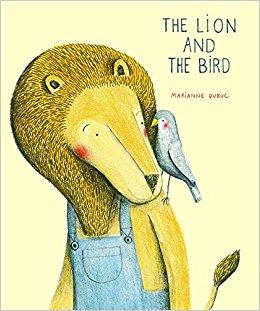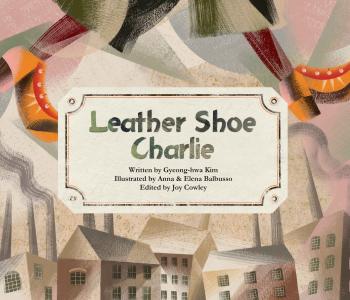
scrounge: /skrounj/ informal verb: to actively seek [books] from any available source

The Lion and the Bird is a beautiful, contemplative story by Montreal author/illustrator Marianne Dubuc, and it was originally published in French. It tells the story of a lion who finds an injured bird in the autumn, and cares for it over the winter. But when spring comes again, the lion understands that the bird has to fly away with the other birds.
One thing I love about the way this tale is told is that it makes space for sadness. Even though the book does leave us with a happy ending, we really feel the loss the lion feels as he walks sadly back to his house after saying goodbye. We watch him wordlessly trying to go about his daily tasks as usual, with the inescapable awareness that someone special is missing. "Sometimes life is like that," we are told.
Not only is there space for sad emotions, but Dubuc gives space for the tale to be told in the first place. At 64 pages, the book manages to feel complete and well-rounded without being "long." It is not overly wordy either -- the sentences are fairly short and simple, going back and forth between the narrator and words spoken by the lion.
The story itself could be summarized quite easily in a sentence or two, but the author makes use of white space, multiple frames, and also a few wordless pages to convey a linear narrative where even the small moments are important. This also gives space for the adult reader to point things out to a child, or ask questions ("How do you think the lion feels right now?") without disrupting the flow of the story.
This story is brief, yet thorough -- succinct, yet spacious, encompassing a look at each of the four seasons, the sadness of letting go, and the beauty of friendship.
Scrounged From: Our local library
Format: Hardcover
Author/Illustrator: Marianne Dubuc
Pages: 64
Content Advisory: None

Leather Shoe Charlie is a beautifully illustrated introduction to the Industrial Revolution. Set in England, it tells the story of a family that migrates to the city of Manchester to find work.
This family includes a boy named Charlie, who proudly wears leather shoes that his cobbler grandfather made for him. The family's new home is dark and cramped, and they all have to work long hours (child labor is referenced but not elaborated on in the story). Despite their difficulties, Charlie's shoes help to remind him of his dream of becoming a cobbler himself one day.
But then his mother develops a persistent cough. Charlie hears that tea is good for a cough, but tea is far too expensive for his family to afford, and so Charlie gives the only item(s) of value that he has to try and help his mother get better. The story ends there, but emphasizes that the loss of his shoes did not cause Charlie to lose sight of his dream.
At the end of the book there are four pages about the Industrial Revolution including information about working and living conditions, key terms, a timeline, and some stats.
I really love the illustrations in this book -- I'm not very proficient at artistic terminology, but I suppose one could call them a bit abstract, with lots of "brushstroke" effects. This led me to the website of the Balbusso Twins, and wow! They have some amazing stuff. I also found out that this book was originally published in Korean.
Considering all the information it contains, this book is a great way to learn about an important facet of history in a way that puts a human face to it. It's also an important reminder that difficult circumstances do not stop children from having dreams.
Scrounged From: A LibraryThing giveaway
Format: Paperback
Author: Gyeong-hwa Kim
Illustrators: Anna Balbusso and Elena Balbusso
Pages: 36
Content Advisory: None


